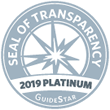THYROID CANCER TUMOR BOARD
NRAS Mutation in a FLUS FNA Mandates Thyroidectomy
Wendy Sacks
CASE PRESENTATION • • • • • • • • • • • • • • • • • • • • • • • •
A 40-year-old woman was found to have a thyroid nodule on examination by her internist. She presented to our center for further evaluation. A 2-cm nodule was palpated, and ultrasound revealed a solitary left lobe nodule measuring 1.2 by 1.83 by 2.5 cm. Ultrasound features suspicious for malignancy, such as microcalcifications, hypoechogenicity, and intranodular vascularity, were absent; a central area of hypoechogenicity was noted (Figure 1). Cytology from an ultrasound-guided fine-needle aspiration (FNA) biopsy suggested a hyperplastic (adenomatoid) nodule, but the SurePath slide showed high cellularity; therefore, the nodule was considered a follicular lesion of undetermined significance (FLUS) (Figure 2). SurePath is a liquid-based preparation in which the cell sediment is emulsified in suspension, the cells separated and laid out on a slide (one per nodule), while red blood cells are lysed to decrease their obscuring effect. Several studies have reported the efficacy of the SurePath preparation (1). A repeat biopsy showed benign cytology with a NRAS mutation by molecular testing.
 |
 |
| Figure 1. Ultrasound of 2.2cm left thyroid nodule, sagittal view. Features include a central hypoechogenic area within an isoechoic nodule and peripheral vascularity. | Figure 2. Cytopathology from thyroid nodule fine needle aspiration demonstrating isolated microfollicles in an otherwise bland appearing specimen. |
ANALYSIS AND COMMENTARY • • • • • •
With the availability of molecular testing, we see more cases similar to this patient. FNA cytology is still the most reliable method of diagnosing a thyroid nodule; however, approximately 25% of nodules fall in the indeterminate category, in which the risk for malignancy for the FLUS/AUS (atypia of undetermined significance) category ranges between 5 and 15% (2). The clinical treatment of these patients can be challenging, and many are sent for surgery even though their tumor is likely to be benign. The ability to test for molecular mutations in FNA specimens provides further information with which to refine our clinical decision-making. With specific reference to the patient presented above, (i) what is her risk for malignancy, (ii) should one recommend conservative management using close monitoring with serial ultrasounds, or (iii) is surgery indicated, and if so, lobectomy or total thyroidectomy?
Nikiforov and colleagues at the University of Pittsburgh evaluated both the incidence and the risk of malignancy in nodules with FLUS/AUS FNA cytology by studying oncogenic mutations (3). Of the 218 patients (247 FNA specimens) with a surgical histologic diagnosis, 32 nodules (35 FNA specimens) were malignant. The molecular panel performed on the FNA specimens demonstrated 21 mutations in 35 malignancies, including 16 RAS (16 follicular variant PTC), 5 BRAF (4 PTC, 1 follicular variant PTC) and 1 PAX8/PPARγ (1 follicular variant PTC) mutation. Three of the nodules with a RAS mutation were benign follicular adenomas on surgical histology. Thus, the positive predictive value (PPV) for malignancy in a FLUS/AUS lesion with any molecular mutation (RAS, BRAF, PAX8/PPARγ) is 88% with 63% sensitivity.
A major concern with the presence of a RAS mutation in a benign nodule is its potential for malignant transformation and dedifferentiation, since it is a potent oncogene (4, 5). The presence of the BRAF V600E mutation confers a 100% PPV for thyroid malignancy, so total thyroidectomy is the appropriate treatment even if the nodule has an indeterminate cytology. Except for BRAF V600E, the other molecular markers in the panel, or gene array studies, do not provide such certainty for indeterminate nodules. The American Thyroid Association guidelines recommend either a hemithyroidectomy or total thyroidectomy as the initial surgical approach for solitary indeterminate nodules (6).
Case Management
The initial cytology in this case conferred a 5% to 15% risk for malignancy, while the second sampling was benign. However, with the presence of an NRAS mutation, we felt the risk for malignancy increased significantly, up to 88% based on the Pittsburgh data. Therefore, we recommended that she have surgery. She opted for a hemithyroidectomy, with the understanding that a completion surgery may be necessary if the pathology proved malignant. Indeed, the final pathology demonstrated a 1.4-cm follicular variant of papillary thyroid carcinoma within a 2.2-cm nodule. For ease of future monitoring, she had a completion thyroidectomy. Whether to do a completion surgery could be debated in this case based on the small size of the tumor and the lack of lymph-node involvement, extrathyroidal extension, and lymphovascular invasion.
References
- Geers C, Bourgain C. Liquid-Based FNAC of the thyroid; A 4-year survey With SurePath. Cancer Cytopathol. 2011; 119:58-67.
- Ali SZ, Cibas ES, eds. The Bethesda System for reporting thyroid cytopathology: definitions, criteria and explanatory notes. New York: Springer, 2010.
- Nikiforov YE, Ohori PN, Hodak SP, Carty SE, LeBeau SO, Ferris RL, Yip L, Seethala RR, Tublin ME, Stang MT, et al. Impact of mutational testing on the diagnosis and management of patients with cytologically indeterminate thyroid nodules: a prospective analysis of 1056 FNA samples. J Clin Endocrinol Metab 2011;96:3390-7. Epub August 31, 2011.
- Fukahori M, Yoshida A, Hayashi H, Yoshihara M, Matsukuma S, Sakuma Y, Koizume S,Okamoto N, Kondo T, Masuda M, Miyagi Y. The associations between RAS mutations and clinical characteristics in follicular thyroid tumors: new insights from a single center and a large patient cohort. Thyroid 2012;22:683-9. Epub May 31, 2012.
- Fagin JA. Minireview: Branded from the start—distinct oncogenic initiating events may determine tumor fate in the thyroid. Mol Endocrinol 2002;16:903-11.
- Cooper DS, Doherty GM, Haugen BR, Kloos RT, Lee SL, Mandel SJ, Mazzaferri EL, McIver B, Pacini F, Schlumberger M, Sherman SI, Steward DL, Tuttle RM. Revised American Thyroid Association management guidelines for patients with thyroid nodules and differentiated thyroid cancer. Thyroid 2009:19:1167-214.
CLINICAL THYROIDOLOGY • MARCH 2013 VOLUME 25 • ISSUE 3• © 2013



